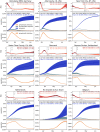This is a preprint.
Visualizing the invisible: The effect of asymptomatic transmission on the outbreak dynamics of COVID-19
- PMID: 32869035
- PMCID: PMC7457606
- DOI: 10.1101/2020.05.23.20111419
Visualizing the invisible: The effect of asymptomatic transmission on the outbreak dynamics of COVID-19
Update in
-
Visualizing the invisible: The effect of asymptomatic transmission on the outbreak dynamics of COVID-19.Comput Methods Appl Mech Eng. 2020 Dec 1;372:113410. doi: 10.1016/j.cma.2020.113410. Epub 2020 Sep 8. Comput Methods Appl Mech Eng. 2020. PMID: 33518823 Free PMC article.
Abstract
Understanding the outbreak dynamics of the COVID-19 pandemic has important implications for successful containment and mitigation strategies. Recent studies suggest that the population prevalence of SARS-CoV-2 antibodies, a proxy for the number of asymptomatic cases, could be an order of magnitude larger than expected from the number of reported symptomatic cases. Knowing the precise prevalence and contagiousness of asymptomatic transmission is critical to estimate the overall dimension and pandemic potential of COVID-19. However, at this stage, the effect of the asymptomatic population, its size, and its outbreak dynamics remain largely unknown. Here we use reported symptomatic case data in conjunction with antibody seroprevalence studies, a mathematical epidemiology model, and a Bayesian framework to infer the epidemiological characteristics of COVID-19. Our model computes, in real time, the time-varying contact rate of the outbreak, and projects the temporal evolution and credible intervals of the effective reproduction number and the symptomatic, asymptomatic, and recovered populations. Our study quantifies the sensitivity of the outbreak dynamics of COVID-19 to three parameters: the effective reproduction number, the ratio between the symptomatic and asymptomatic populations, and the infectious periods of both groups For nine distinct locations, our model estimates the fraction of the population that has been infected and recovered by Jun 15, 2020 to 24.15% (95% CI: 20.48%-28.14%) for Heinsberg (NRW, Germany), 2.40% (95% CI: 2.09%-2.76%) for Ada County (ID, USA), 46.19% (95% CI: 45.81%-46.60%) for New York City (NY, USA), 11.26% (95% CI: 7.21%-16.03%) for Santa Clara County (CA, USA), 3.09% (95% CI: 2.27%-4.03%) for Denmark, 12.35% (95% CI: 10.03%-15.18%) for Geneva Canton (Switzerland), 5.24% (95% CI: 4.84%-5.70%) for the Netherlands, 1.53% (95% CI: 0.76%-2.62%) for Rio Grande do Sul (Brazil), and 5.32% (95% CI: 4.77%-5.93%) for Belgium. Our method traces the initial outbreak date in Santa Clara County back to January 20, 2020 (95% CI: December 29, 2019 - February 13, 2020). Our results could significantly change our understanding and management of the COVID-19 pandemic: A large asymptomatic population will make isolation, containment, and tracing of individual cases challenging. Instead, managing community transmission through increasing population awareness, promoting physical distancing, and encouraging behavioral changes could become more relevant.
Figures









Similar articles
-
Visualizing the invisible: The effect of asymptomatic transmission on the outbreak dynamics of COVID-19.Comput Methods Appl Mech Eng. 2020 Dec 1;372:113410. doi: 10.1016/j.cma.2020.113410. Epub 2020 Sep 8. Comput Methods Appl Mech Eng. 2020. PMID: 33518823 Free PMC article.
-
Tracing day-zero and forecasting the COVID-19 outbreak in Lombardy, Italy: A compartmental modelling and numerical optimization approach.PLoS One. 2020 Oct 30;15(10):e0240649. doi: 10.1371/journal.pone.0240649. eCollection 2020. PLoS One. 2020. PMID: 33125393 Free PMC article.
-
Effectiveness and cost-effectiveness of four different strategies for SARS-CoV-2 surveillance in the general population (CoV-Surv Study): a structured summary of a study protocol for a cluster-randomised, two-factorial controlled trial.Trials. 2021 Jan 8;22(1):39. doi: 10.1186/s13063-020-04982-z. Trials. 2021. PMID: 33419461 Free PMC article.
-
Universal screening for SARS-CoV-2 infection: a rapid review.Cochrane Database Syst Rev. 2020 Sep 15;9(9):CD013718. doi: 10.1002/14651858.CD013718. Cochrane Database Syst Rev. 2020. PMID: 33502003 Free PMC article.
-
Digital contact tracing technologies in epidemics: a rapid review.Cochrane Database Syst Rev. 2020 Aug 18;8(8):CD013699. doi: 10.1002/14651858.CD013699. Cochrane Database Syst Rev. 2020. PMID: 33502000 Free PMC article.
References
-
- Allday E., Kawahara M.. First known U.S. coronavirus death occurred on Feb. 6 in Santa Clara County. San Francisco Chronicle, April 22, 2020. https://www.sfchronicle.com/health/article/First-known-U-S-coronavirus-d... assessed: Jun 15, 2020.
-
- Aron J. L., Schwartz I. B.. Seasonality and period-doubling bifurcation in an epidemic model. Journal of Theoretical Biology 110 (1984) 665–679. - PubMed
-
- Bendavic E., Mulaney B., Sood N., Shah S., Ling E., Bromley-Dulfano R., Lai C., Weissberg Z., Saavedra-Walker R., Tedrow J., Tversky D., Bogan A., Kupiec T., Eichner D., Gupta R., Ioannidis J.P.A., Bhattacharya J.. COVID-19 antibody seroprevalence in Santa Clara County, California. medRxiv doi:10.1101/2020.04.14.20062463 - DOI - PMC - PubMed
-
- Painel de casos de doença pelo coronavírus 2019 (COVID-19) no Brasil pelo Ministerio da Saude. www.covid.saude.gov.br/ assessed: Jun 15, 2020.
Publication types
Grants and funding
LinkOut - more resources
Full Text Sources
Research Materials
Miscellaneous
